When constructing a brand-new laboratory or renovating an existing one, you need to be aware of the essential pieces of Scientific Equipment Supplier that it must have to operate well. Some pieces of equipment are necessary for every laboratory, even though the detailed list may change depending on the requirements of your lab.
Before you make any purchases, please review the following list of laboratory equipment:
1. Funnels and Bottles
To carry out experiments that require the use of liquids, you will need funnels and bottles of varying heights, widths, and lengths of the stems. The mouths of these funnels and bottles are often designed to be small so liquids may be poured more easily. They come in both plastic and glass if that’s what you like. Learn about Double R Optics.
2. Beakers
Beakers are an essential piece of Scientific Equipment Manufacturer that may be used for various tasks, including dissolving or stirring solutions, heating or cooling liquids, and combining chemicals. Some beakers are designed with a wide mouth, a flat bottom, and a spout in the style of a beak to make them easier to handle. On the other hand, there are also test tubes shaped like various beakers that you may purchase.
3. Flask Conical in Shape
When you need to stir or shake liquids in the lab without having to worry about them spilling, you may put this lab equipment to good use. The aperture is somewhat constrictive but widens as it gets closer to the base. Because of its tight opening, it is possible to seal it with a glass or rubber stopper and then set it away in a secure location for later use. Clamping it to a ring stand will also allow it to be used for heating.
4. Lab Stands
Beakers and flasks may be held over a heat source using the rings or clamps included with lab stands. Depending on the specifics of your application, they may be purchased in various clamp and ring sizes and design styles.
5. Test Tubes
A test tube is a transparent container made of glass or plastic that is formed like a cylinder and has a bottom in the shape of a U. Because it is non-reactive apparatus, you are free to carry out experiments that involve a chemical reaction without fear of harm to yourself or others. In addition to that, scientific samples might be stored there.
6. Microscopes
Without microscopes, a science lab’s collection of scientific equipment supplier is lacking, particularly in microbiology. Depending on the circumstances, you can purchase a microscope with low power, a high power, or both.
7. Burettes and Pipettes
Burettes and pipettes are instruments that resemble skinny tubes and are used to transport very minute amounts of liquid. Its purpose is to distribute the appropriate quantity of the liquid being utilized. Although they provide the same function, the two may be combined in various ways. The pipette is a more compact option than the burette.
The process by which they release their contents is the primary distinction between them. A pipette operates on a dropper-like method. However, a burette includes a stopcock at the bottom. This allows the pipette to release liquid in the correct quantity by decreasing the vacuum within the burette.

